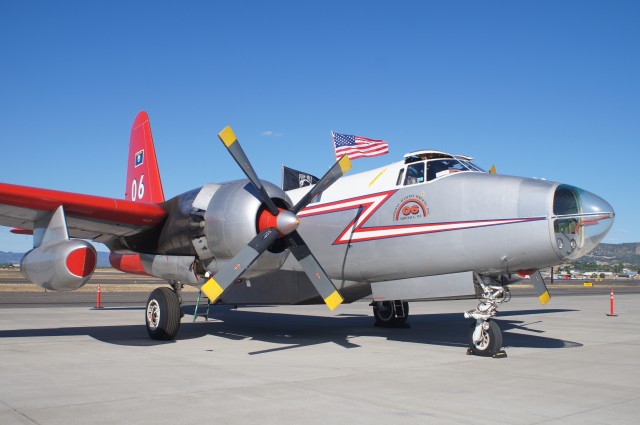
06 Lockheed P2V fire-fighting aircraft – Photo: Julian Cordle
Fall brings cool, wet weather, which serves as a huge relief to areas devastated by the 2014 US wildfire season. In the last sixty days, a number of high-profile tragedies have highlighted the dangers of wildfires. In September, the town of Weed, California was nearly wiped out by the vicious Boles Fire, which destroyed over 150 homes and buildings. Just a few weeks ago, CalFire Pilot Craig Hunt was killed when his S-2 tanker crashed while fighting the Dog Rock Fire near Yosemite National Park.
In the spirit of respect and appreciation for the efforts of all forest firefighters, aerial and “ground-pounders” alike, AirlineReporter offers this two-part series on Aerial Firefighting.
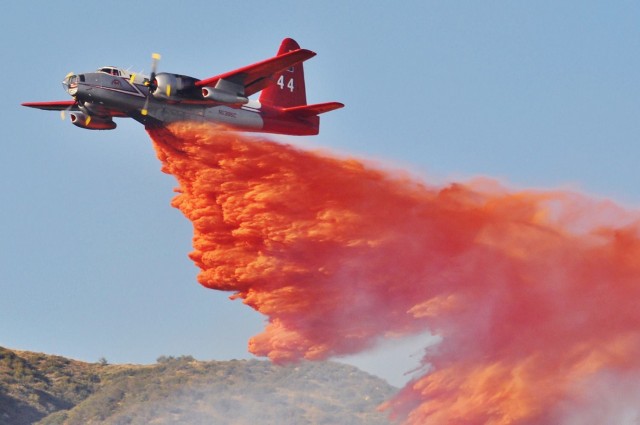
P2V Neptune fire tanker dropping borate fire retardant on the mountainside in an effort to contain a wildfire – Photo: Jeremy Ulloa
The 2014 fire season began with a bang, as an early season fire in Alaska consumed nearly 200,000 acres before a badly needed weather system put it to rest. About the same time, a vicious collection of fires raged through heavily populated areas of Southern California. All of this took place before we had even seen the first day of June.
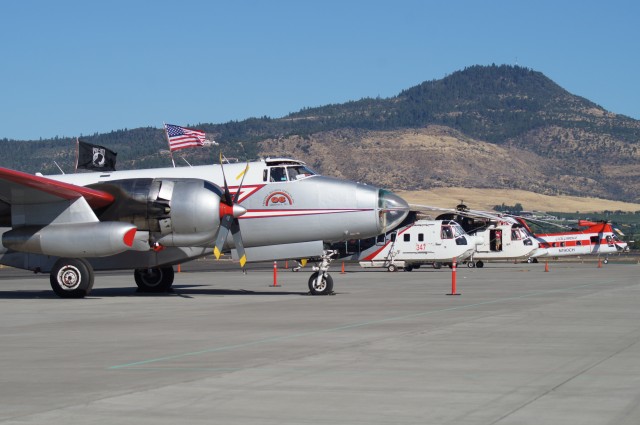
Flight line of aircraft waiting to do their job – Photo: Julian Cordle
When fire season begins, “Air Attack” resources are often moved into the Medford Air Tanker Base at Rogue Valley International Medford Airport in Medford, Oregon (KMFR), just a few miles from my home. Thanks to Neptune Aviation Pilot Chris Holm and COO Dan Snyder, I had a chance to sit down and talk fire suppression tactics, learn the recent history of aerial firefighting (AF), and even get up close and personal with the aircraft serving in these critical roles.
One of the first things I learned from Chris is that the best AF pilots need to be as good at understanding fire behavior as they are flying aircraft. Chris, for instance, spent years on the ground in firefighting handcrews before deciding to take on the challenge of flying Air Attack aircraft, which he’s been doing since 1997. This experience on the ground has given him keen insight into where and how to execute drops, and it also makes him a valuable resource to incident commanders, who often must rely on “eyes in the sky” to see the movement of a fire.
If that wasn’t enough, AF pilots must execute difficult maneuvers through mountainous canyons, valleys, and populated areas. Have you ever seen a DC-10 fly nose-down a mountain ridge in “full dirty” flight configuration while unloading 100,000 lbs. of “mud”? Brace yourself, because here it is.
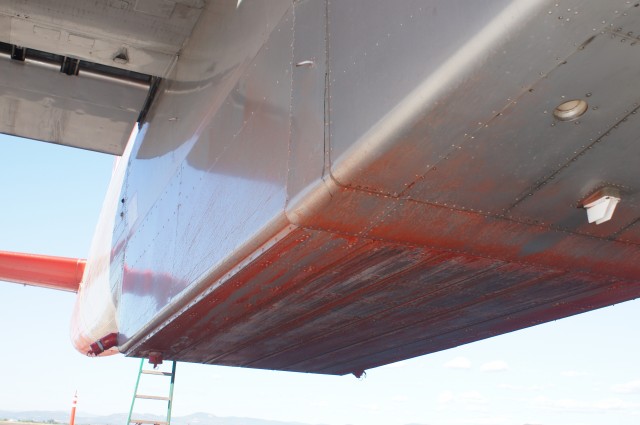
Some of the “mud” left on the tail of the aircraft – Photo: Julian Cordle
“Mud” is the not-so-friendly name for fire retardant. Biodegradable chemicals are added to water to help the mud “stick” to trees and foliage, and an iron-red dye helps pilots easily locate existing drops from the air. Mud is relatively dense, coming in at about 9 lbs. per gallon. In order to do its job, AF pilots must drop the retardant at about 150 feet AGL at a speed of 120-130 MPH. Any slower or higher, and the retardant has a tendency to disperse into a useless mist before reaching the forest. Any faster or lower, and the retardant will splatter itself to only one side of the trees and vegetation, allowing the fire to burn through the line. It’s a delicate balance to get the retardant to float perfectly onto the trees with just the right coverage.
Except for “scooper” aircraft and “helitack” efforts (rotary-wing), most aerial firefighting work in our area involves air tankers dropping retardant on location, then returning to “base” to land and get reloaded with more mud. Contrary to popular belief, mud is rarely dropped directly onto a burning fire, unless there is an imminent threat to life or property. Instead, pilots drop lines of retardant and use “anchor, flank, and pinch” tactics to surround the fire, or at least suppress the advancement of it while ground crews build more permanent fire lines with teams of men and equipment.
- Anchor means to find a suitable natural (or man-made) defensible line in the terrain which the fire is unlikely to jump. This would be things like a forest road, a river/stream, or the shore of a lake, where a line of retardant can be laid down at a perpendicular angle to create a solid “anchor point” from which to build a containment line.
- To flank is to drop new lines of retardant from the anchor point ahead of the expected burn path of the flames while…
- Pinching the fire, which is achieved by using lines to cut off all burnable areas and “pinching” the fire back to the anchor point or previously burned location, resulting in 100% containment.
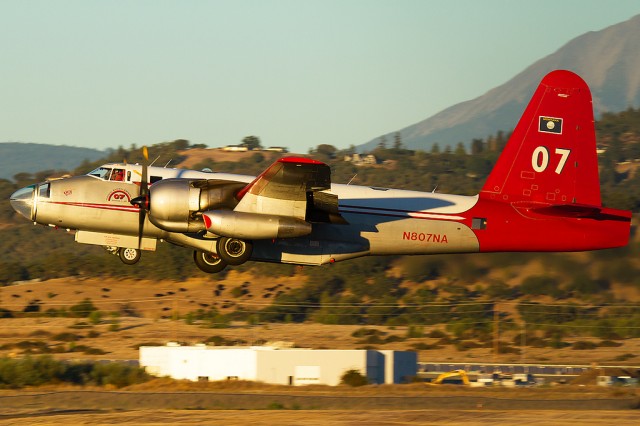
Lockheed P2V-5 taking off from Medford – Photo: Russell Hill
It sounds simple, but it’s clear from my discussions with Chris that his calmness and humility hide just how important his years of experience working to understand fire behavior are. The danger to human life cannot be overstated. As an example, he warns that due to the natural tendency of flames to burn up the trunks and branches of trees, fires traveling uphill burn fiercely and are extremely fast, intense, and difficult to stop. He approaches those situations with special respect.
As if all that wasn’t enough, aerial firefighting has had its own demons to contend with in recent years. Consider this, from a 2002 report to the USFS and BLM by aerial firefighting industry experts: “The safety record of fixed-wing aircraft and helicopters used in wildland fire management is unacceptable.”
The 2002 season was an especially deadly year for aerial firefighting, with two separate high-profile in-flight breakups of air tankers resulting in a number of fatalities. Chris remembers this time well. After all, aerial wildfire pilots, even pilots from different organizations, often work side-by-side fighting the same fires, so it was his friends and colleagues who lost their lives in those accidents.
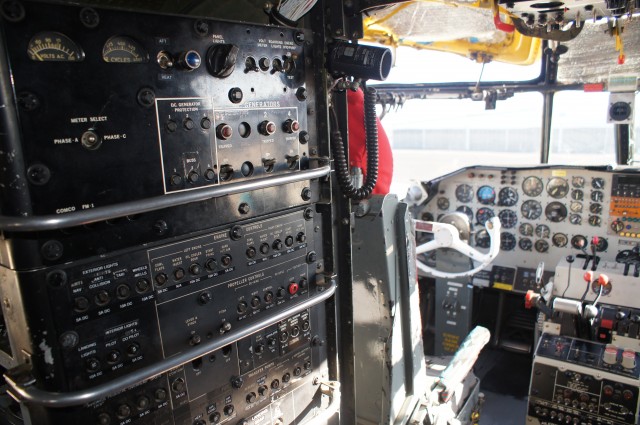
Flight deck of the P2V – Photo: Julian Cordle
Until 2002, conversions of older aircraft into air tankers was generally believed to be as safe as the aircraft’s original design role, as long as aircraft maintenance was consistent and timely, and that aircraft were not overloaded (in respect to their original design limitations). Basically, it was assumed that the air tankers, even old ones, could safely be flown indefinitely, as long as the manufacturer’s maintenance schedules were adhered to.
What the report concluded, however, was that a combination of factors, including a lack of FAA oversight into air tanker safety operations and the USFS’s own internal pressure to award contracts based primarily on the lowest total cost for services (read “oldest and cheapest aircraft”) led to an environment where these disasters could occur. The effects of this brutally honest investigation were immediate and powerful. In short, the report caused a reboot of ALL air tanker operations, including a command by the USFS to immediately ground older tankers outright until newer safety standards could be established and the planes could be proven safe.
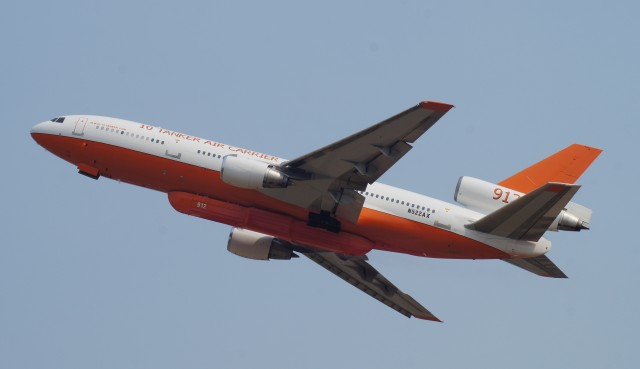
Tanker 912, a DC-10 air tanker used to fight fires – Photo: Julian Cordle
Today, Chris tells me, in large part due to the events of 2002, we know far more about the true “cost” of aerial firefighting on the reliability of older airframes. Maintenance intervals are shorter, and firefighting missions are assigned a multiplier penalty that calculates flight hours at a faster rate than standard flight hours. Neptune Aviation, in particular, has invested substantially into the safety, reliability, and efficiency of the aircraft they fly, spending millions of dollars developing their own top-notch testing and analysis equipment, maintenance programs, parts warehousing and tracking, and tear down/rebuild processes.
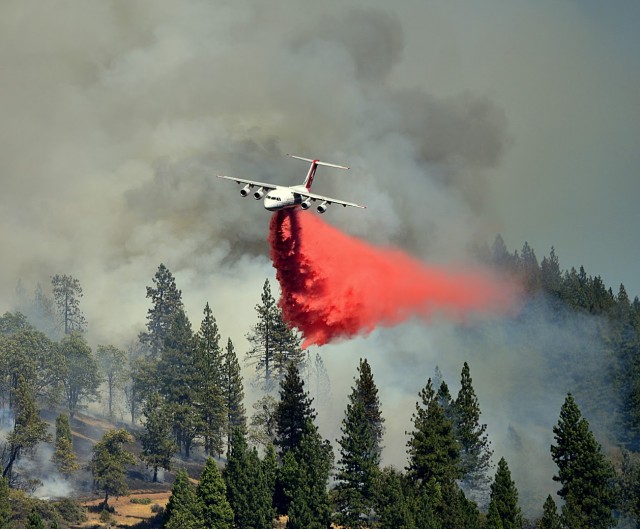
BAe-146 tanker doing its job – Photo: Jonah Curtin
Currently, Neptune Aviation operates seven older Lockheed P2V Air Tankers, which are based on designs dating back to 1945. In the next section, we’ll look at how Neptune Aviation keeps these older tankers flying safely under heightened regulations, take a look at the new BAe-146 Tankers, and, through sheer luck, see what it’s like to be on the ramp of a major airport when aerial firefighting operations are conducted on the busiest day of firefighting in years.
Comments are closed here.
Great story! Wish I was the reporter on this one!
Thom – Glad you like it. It’s been great fun to get up close with these birds.
Part Two will have some pretty cool details on the aircraft. Stay tuned!